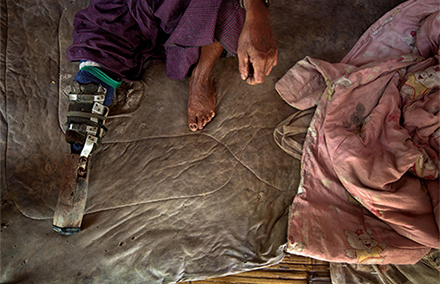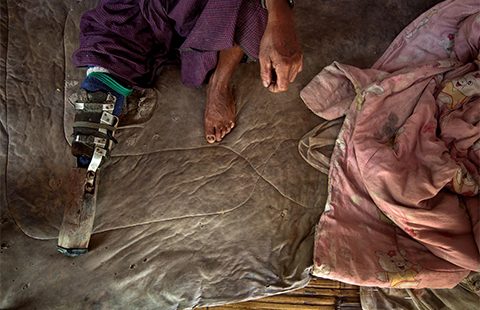
Photo: Giovanni Diffidenti via ICBL on flickr https://www.flickr.com/photos/minefreeworld/
Landmines are the missing link in the country’s ceasefire process.
Since 2012, Myanmar’s political opening has resulted in the signing of 15 bilateral ceasefires with armed ethnic groups, with negotiations towards a national ceasefire accord continuing.
Yet despite this, as Min Zaw Oo from Myanmar Peace Centre recently stated, it is pertinent to remember that four in 10 Myanmar people still live in conflict affected areas[1].
The ongoing conflicts bring with them the danger of landmines. The most recent casualty rates from the International Campaign to Ban Landmines ranks Myanmar third internationally in terms of accidents from these deadly weapons[2].
It’s unsurprising then that a recent survey also showed 65 per cent of households interviewed reported an accident with landmines in their village[3].
Alongside the physical and psychological impacts, the presence of landmines in many communities limits the access of humanitarian actors, poses a barrier to water, wash and livelihood initiatives, and constrains other critical development activities[4].
Many conflict affected and displaced communities have yet to be meaningfully engaged in ceasefire development or political decisions in their locales and continue to face dangers from landmines on a daily basis in isolation.
Currently, four of the 15 bilateral ceasefires, two with KNU, have included ‘demining’ or consideration of boarder mine action[5].
| Group | Process Phase | Demining Included | Member of Nationwde Ceasefire Coordination Team (NCCT) |
| Karenni National People’s Party (KNPP) | 3rd, Union Level(23.10.13) | Yes | Yes |
| Karen National Union (KNU) | Pre State Level(12.1.12) | Yes | Yes |
| Karen National Union (KNU) | 2nd Union Level(4.9.12) | Yes | Yes |
| Shan State Army/Restoration Council of the Shan State (SSA/RCSS) | State Level(2.12.11) | Yes | No |
| Kachin Independence Army (KIA) | Pre-CS(10.10.13) | Yes | Yes |
Meanwhile Geneva Call[6], an international NGO working specifically with non-state actors, has signed a series of deeds of commitment with a number of ethnic armed organisations that declare a ban on the use of landmines.
| Group | Part of NCCT |
| Arakan Rohingya National Organization (ARNO) | No |
| Chin National Front/Army (CNF/CNA) | Yes |
| Karen National Union/Karen National Liberation Army (KNU/KNLA) | Yes |
| Lahu Democratic Front (LDF) | Yes |
| National Unity Party of Arakan (NUPA) | No |
| Pa’O Peoples Liberation organization (PPLO) | Yes |
| Palaung State Liberation Front / Ta-an National Liberation Army (PSLF/TNLA) | Yes |
However, despite these positive steps there remains no broad consensus on how to address the issue of landmines in the country. The language between the respective bilateral ceasefires is different and the language used in the deeds of commitment were not intended to, nor reflect that of bilateral ceasefires.
While the relationship of existing bilateral ceasefires to the National Ceasefire Agreement (NCA) are yet to be clarified, it is clear that the NCA has taken significant steps towards a ban on the use of landmines.
These include discussions on the role of de-mining in the nationwide ceasefire. A reference to the March 2015 draft reads, “Both parties agree to end the following activities: …. planting of landmines”.
Another section outlines more detail:
In line with progress on the peace process, both parties agree to cooperate on the process of clearing all landmines planted by both sides’ armies. Joint efforts on landmine clearing projects shall be carried out in close consultation with different levels of the government[7].
Accordingly, the Myanmar Mine Action Centre (MMAC), structurally placed under the Myanmar Peace Centre (MPC), was envisaged to cover coordination of all Humanitarian Mine Action pillars.[8] However, there has been a general tendency from parties to conflict to delay any form of mine action until clear provisions, most specifically for landmine clearance, have been agreed in the national ceasefire accord (NCA).[9]

Photo: Photo: Giovanni Diffidenti via ICBL on flickr https://www.flickr.com/photos/minefreeworld/
While, the MMAC awaits outcomes of dialogue on national ceasefire before taking more active role in support of Union/State Governments and the Military its role in supporting ethnic armed organisations is currently unclear[10].
But what models of clearance, risk education and support for landmine survivors would be appropriate for the Centre to endorse? What kind of authority, if any, could be expected from parties to the NCA for coordinating mine action through the MPC?
Is the start point the MPC or should engagement occur with relevant ethnic bodies such as the Karen Mine Action Centre? These are key questions that will be critical to answer if populations are to be free from the risk of landmines.
By assessing the models and viewpoints of the diverse range of parties included in the NCA, a deeper and better understood role of ‘de-mining’ than already exists in bilateral and draft national ceasefire accords can be determined.
In this way, the mine action sector can build greater understanding on the technical capacity and models currently used by a range of different actors in the country, including, the military, Union and State Governments, as well ethnic armed organisations. Existing models can provide start points for highlighting relevant international approaches in order to continually build quality and safe practices.
Broader linkages, within the purview of ‘interim arrangements’, could lead to more formal mechanisms for coordinating mine action with the delivery of humanitarian and development aid in areas administered by ethnic armed organisations[11].
Extending these mechanisms to promote engagement at community level will better inform Myanmar Government and ethnic group representatives on local priorities. In this way village based priorities can be integrated into the planning, management and implementation of mine action with humanitarian and development actions at various administrative levels.
Ensuring mine clearance and risk education models are locally contextualised and led will enable humanitarian and development actors to be better informed on the potential landmine hazards existing in local areas from the start.
Efficient prioritisation of expensive mine clearance operations can take place according to inclusive and agreed priorities. This will result in more targeted, quicker, safer and more effective development outcomes for populations.
A platform to comprehensively assess the priorities and models for integrating mine action within bilateral and draft national ceasefires provides a start point to better define the role of mine action in humanitarian response, rehabilitation, development and peace building in Myanmar.
Gregory Cathcart is an international development consultant focusing on community perspectives regarding landmine/unexploded ordnance (UXO) related issues in Southeast Asia. Previously, he worked with the Lao Government to develop a non-technical UXO survey that combined household socio-economic assessments and village based land use planning to direct UXO Technical survey and clearance priorities. He has a Master’s Degree in Public Health and is currently working with Ethnic Peace Resource Project (EPRP).
Endnotes
[1] Presentation at 2015 ANU Myanmar/Burma Update. Accessed 5 October 2015, http://asiapacific.anu.edu.au/asiapacific-region/2015-myanmarburma-update
[2] After Afghanistan and Columbia, http://www.the-monitor.org/custom/index.php/region_profiles/print_profile/948, Accessed 15 January 2015.
[3] MRE KAP Survey: South-East Myanmar, UNCIEF and DanChurch Aid, Unpublished, 2015,
[4] 13 per cent of internally displaced people (IDP) in Kachin and Northern Shan reported landmines prevented them from accessing firewood, MRE KAP Kachin and Northern Shan, Unpublished, 2015.
[5] http://www.swisspeace.ch/fileadmin/user_upload/Media/Publications/Catalyzing_Reflections_2_2014_online.pd
[6]An international NGO working with non-state armed groups on protection issues, www.genevacall.org
[7] http://burma.icbl.org/?p=641, The Mine Ban and the National ceasefire process,
[8] There are five pillars of Mine Action, Victims Assistance, Mine Risk Education, Advocacy, Clearance and Stockpile destruction, http://www.mineaction.org/issues, Accessed 1 May, 2015
[9] Representing a general view that mine action is only ‘de-mining’ with little consideration of models that can include consistent implementation of all pillars of mine action. De-mining delayed until peace agreed, http://www.mmtimes.com/index.php/national-news/12470-de-mining-delayed-until-peace-agreed.html, Accessed April 29, 2015
[10]The inclusiveness of MMAC has been questioned by some international observers, as evidenced by the drafting of national standards occurring in Yangon with most technical input coming from representatives from international humanitarian mine action organisations with little Myanmar representation and little or no input from ethnic armed organisations. Stakeholder Interview, Yangon, May 2013.
[11] Interim Arrangements refers to: 25. ‘The Ethnic Armed Organizations that are signatories to this agreement have been responsible for development and security in their respective areas. During the interim period of holding peace talks, we shall carry out the following programs and projects in consultation with each other in said areas.
 Facebook
Facebook  Twitter
Twitter  Soundcloud
Soundcloud  Youtube
Youtube  Rss
Rss 